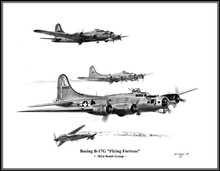 Loading... Please wait...
Loading... Please wait...- Home
- Combat Aircraft/Pencil Drawings ~ Free Shipping
- Boeing B-17G "Flying Fortress" ~ 381st B.G. ~ Free Shipping
Product Description
Print Size 8½" x 11" ~ Unlimited print edition
The Boeing B-17 Flying Fortress is an American four-engined heavy bomber aircraft developed in the 1930s for the United States Army Air Corps (USAAC). A fast and high-flying bomber, the B-17 dropped more bombs than any other aircraft during World War II, used primarily in the European Theater of Operations. It is the third-most produced bomber in history, behind the American four-engined Consolidated B-24 Liberator and the German multirole, twin-engined Junkers Ju 88. The B-17 was also employed in transport, anti-submarine warfare, and search and rescue roles.
In a USAAC competition, Boeing's prototype Model 299/XB-17 outperformed two other entries but crashed, losing the initial 200-bomber contract to the Douglas B-18 Bolo. Still, the Air Corps ordered 13 more B-17s for further evaluation, which were introduced into service in 1938. The B-17 evolved through numerous design advances but from its inception, the USAAC (from 1941 the United States Army Air Forces, USAAF) promoted the aircraft as a strategic weapon. It was a relatively fast, high-flying, long-range bomber with heavy defensive armament at the expense of bomb load. It also developed a reputation for toughness based upon stories and photos of badly damaged B-17s safely returning to base.
The B-17 saw early action in the Pacific War, where it conducted air raids against Japanese shipping and airfields. But it was primarily employed by the USAAF in the daylight component of the Allied strategic bombing campaign over Europe, complementing RAF Bomber Command's night bombers in attacking German industrial, military and civilian targets. Of the roughly 1.5 million tons of bombs dropped on Nazi Germany and its occupied territories by Allied aircraft, over 640,000 tons (42.6%) were dropped from B-17s.














